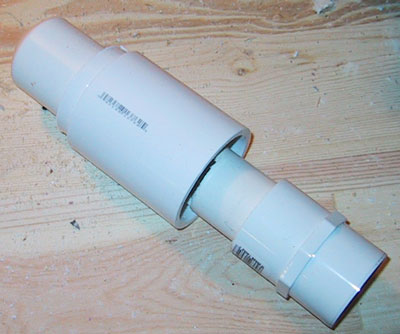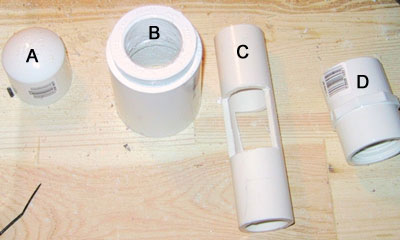

This simple modification is a take of the Durso Standpipe, for reef ready aquariums, but has been adapted for most common overflows. The benefit of this modification is to silence the overflow giving surprisingly good results. My foam pre-filter was very noisy once I upgraded my return pump to get better circulation. I tried a couple of methods, using a ballvalve below the overflow to restrict flow thus raising the waterline in the overflow to silence the gurgling. This lead to a wet carpet! I then tried a method suggested my Jeff at Lifereef. I threaded airline tubing from the overflow down to the sump. Then I slowly pulled the airline back up and listened for the airline to begin sucking air, which equalizes the pressure in the plumbing thus eliminating noise. This worked very well however needed regular adjustment and sometimes proved frustrating finding the "sweet spot" when the airline sucked air.
The Stockman modification is a permanent solution, but is by no means perfect. Expect a certain amount of fiddling to get it right and be sure you have some spare time after installing it to make sure the modification doesn't restrict flow thus causing the tank to overflow. Also I highly recommend using a gatevalve on your return pump. In case the overflow can't handle the full force of the pump you can always scale it back a little.

PVC Parts List
1" cap, hole drilled at top
1.5" coupling with 1" to 1.5" adapter already inserted
1" PVC opened up about 80% with a Dremel tool
1" coupling to attach modification to overflow (optional)
All the above parts should be readily available at your local plumbing or hardware store (or see my links section for online plumbing supply). They are non-toxic and perfectly safe. Drill a hole in the cap, Part A, to allow some allow air to flow down. This equalizes pressure in the plumbing down to the sump, whether PVC or hose, eliminating the dreaded "toilet gurgle" noise. I drilled a 1/8" hole in the cap. Some people even install an air valve to control the amount of air but I didn't find this step necessary. Take a look at your overflow. You will want to cut Part C so when attached to the overflow outlet it sticks about 1" above the barrier where the water spills in; this eliminates the "waterfall" noise. Part C is commonly drilled with many holes instead of just a large opening. Because my return pump was stronger than my overflow I tried to maximize the flow by making the opening wider and wider until I finally just used my Dremel tool with a cutting disc to cut the hole. The sides are about .5" while the rest is cut open. You may find that just drilling several holes restricts the flow a little, in this case you might copy the way I made Part C. The coupling is needed for a Lifereef overflow but A, B, and C are all that is needed for an AquaClear overflow. For a more detailed explanation please click here.